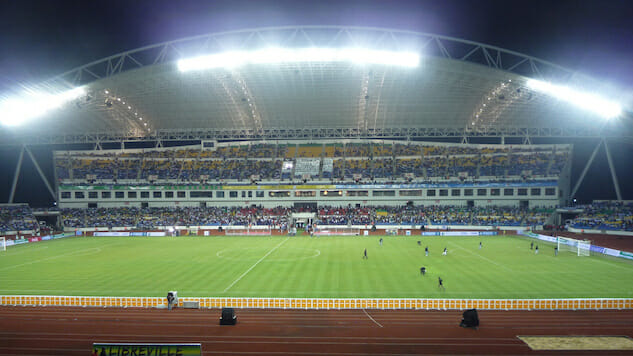Starting this Saturday, national teams from all across the continent will take to the pitch in Gabon for the 2017 African Cup of Nations. The tournament will be a source of national pride for the hosts, particularly if their underdog squad surpasses expectations. However, AFCON 2017 is meant to serve another nation’s power and influence, one outside the African continent: China.
Three of the four stadiums that will host matches over the next month were in effect “gifts” from the Chinese government to the people of Gabon. One, which opened in the capital of Libreville in 2011 and was built by the Shanghai Construction Group, is even nicknamed the “Stade de l’Amitié,” a sign of Sino-Gabonese friendship. These are concrete examples of a brand of soft diplomacy which has given China a unique role in the beautiful game in Africa.
While the Chinese Super League has made headlines in the last year as its clubs used astronomical salaries to poach European stars—or even referees—Chinese “Stadium Diplomacy” is nothing new to other parts of the world. Some of these projects were supported by concessionary loans, some were constructed by state-run entities like the Shanghai Construction Group, and others were paid for by a foreign aid grant from the Chinese government. However, all of these projects are part of a concerted diplomatic effort that started in the latter half of the Twentieth Century and is still going strong.
They crop up all over the place. Costa Rica’s national team, the highest-ranked member of CONCACAF, has played since 2011 in a 35,000-seat stadium for which China footed the entirety of the $100 million bill. A Chinese company recently renovated the Kenyan national team’s home, Moi Internatoinal Sports Centre, which China paid to build in 1987. Myanmar’s national stadium was built by Chinese money in 1985.
Given that altruism is rarely a motivator in international diplomacy, it should come as no surprise that China often earns a return on their investment. When Grenada needed aid after a devastating hurricane in 2004, for instance, it agreed to accept a generous aid package from Taiwan. When the People’s Republic came in with a better offer, however, Grenada’s Prime Minister reneged on the deal with the Taiwanese. Relations between the two island nations broke down, and China gained one more ally in its fight against the international recognition of Taiwan. Two years later, a cricket stadium built with Chinese labor and money opened in the capital of St. George’s.
China’s assistance in building three Gabonese stadiums appears to serve a different but similarly calculating end. The West African nation, whose economy is rooted in exporting crude oil, timber, and other raw materials, has plenty to offer a resource-hungry superpower. It is also in need of symbols of progress and national unity, particularly amid protests against the re-election of President Ali Bongo Ondimba, whose family has controlled the presidency since 1967.
The Chinese government can provide these symbols, with the implied understanding that its friendly gestures will lead to certain economic incentives. Gabon, like recent hosts and stadium recipients Angola and Equatorial Guinea, is one of China’s largest trading partners in Africa.
China’s foreign aid expenditures and economic interests in Africa are enormous and varied, with stadiums forming just a small percentage, but the impact of the stadiums is impossible to ignore. The last six Cups of Nations have taken place in Gabon, Equatorial Guinea, South Africa, Gabon and Equatorial Guinea in a joint bid, Angola, and Ghana. South Africa, which overhauled its stadium infrastructure before hosting the 2010 World Cup, is the only nation on that list not to have used a Chinese built or funded stadium for the tournament.
With 56 member nations, the Confederation of African Football could theoretically go the next hundred years without choosing the same host nation twice for the Cup of Nations. Naturally, however, the CAF can only award the tournament to stable nations with suitable stadium infrastructure. That means nations that export raw materials to China tend to have a leg up in the AFCON bidding process.
Compared to FIFA’s manifestly corrupt World Cup host-selections, stadium diplomacy may seem like a refreshingly straightforward way to influence a tournament bidding process, but it’s still problematic. Too often, Chinese-built stadiums and the tournaments they host serve as symbols of false progress, propaganda for governments that haven’t done enough or are not able to improve football infrastructure.
The stadiums can also put a crowd-pleasing face on activities that deserve serious scrutiny. In Zambia, for example, Chinese-run copper fields have been the scene of over 40 deaths and, according to Human Rights Watch, serious abuse and exploitation of workers. Despite protests against these practices, in 2010 the government accepted China’s offer of a 49,800-seat stadium in Ndola, center of Zambia’s “Copperbelt.”
Of course, these countries cannot be blamed for accepting free stadiums, particularly when the only strings attached are trade deals that will benefit the local economy. But stadium diplomacy does have real-world implications, just one of which may be the location of this year’s Cup of Nations, and it remains a potent example of the inextricable links between geopolitics and global soccer.
